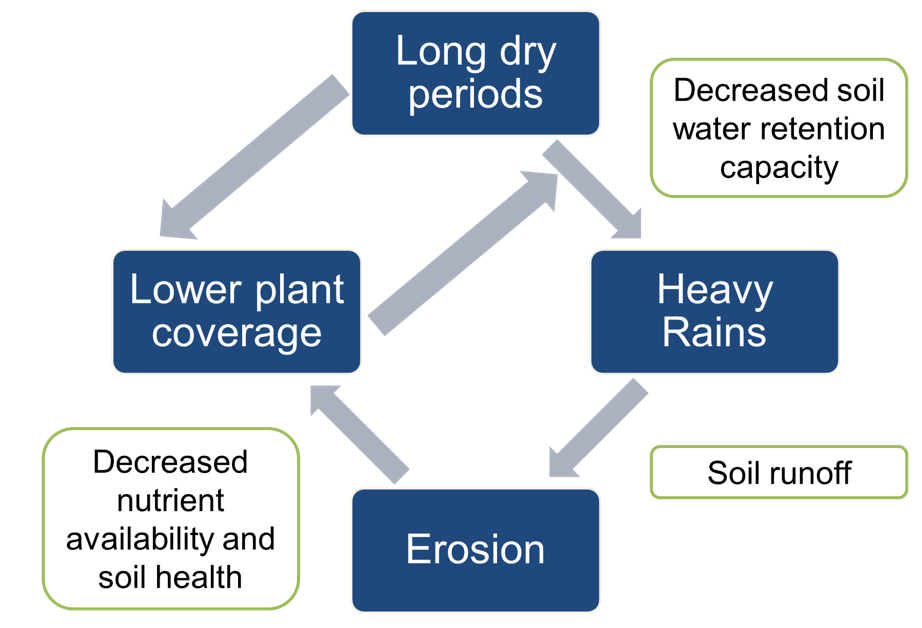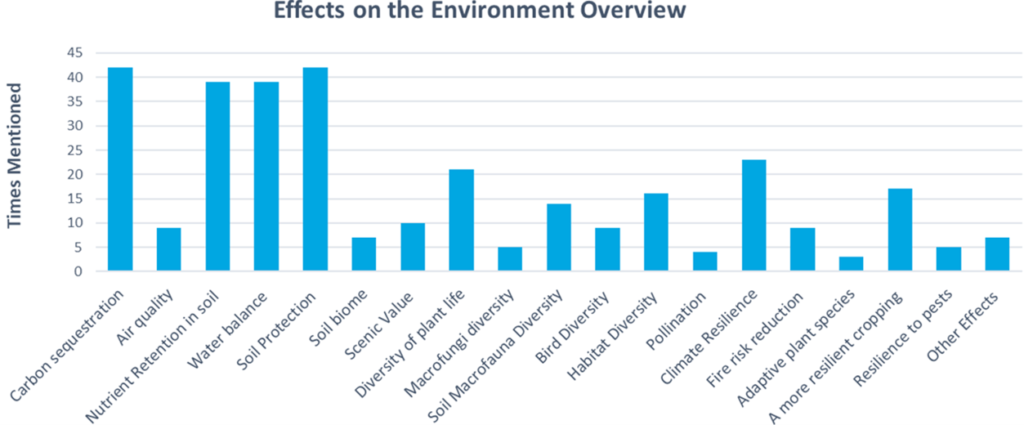The understanding of nature-based negative emission solutions often focuses on their mitigation potential, thus as means for reaching carbon neutrality by 2050. However, this is only one small part of the whole picture; these techniques represent a more sustainable model that brings many environmental benefits in the long term.
It can be difficult to persuade farmers and other stakeholders to adopt nature-based negative emission solutions. Part of the reason for this is that to many people, the phrase ‘Nature-based negative emissions solutions’ sounds a bit like a bizarre mix of state-of-the-art science and new-age mysticism.
But the reality is that these ‘solutions’ are much more familiar than their name suggests. When we talk about nature-based negative emissions, we are simply referring to a series of land-use techniques that people have been using for centuries. By highlighting their negative emission potential, we are simply recognising an important and beneficial side-effect of these techniques.
But our research shows that these techniques also have a host of other benefits. For instance, they also increase resilience and mitigate some of the most serious climate risks land users face. Also focussing on these benefits – rather than only on negative emissions – might prove an easier path to persuading land users to take these practices up.
Why nature-based negative emissions solutions are less complicated than you think
Nature-based negative emissions solutions are land-use techniques that allow capturing greenhouse gas emissions. The LANDMARC project assesses several of these techniques, ranging from quite well-known ones, such as reforestation, to less obvious ones, such as the rewetting of wetlands or different modalities of organic agriculture.
But, crucially, many of these techniques are traditional to their original regions, and are well adapted to the local environment, but have been largely displaced by more standardized, industrial land use techniques. The original purpose of these techniques was not to capture greenhouse gases; this happens as a side effect.
The LANDMARC project interviewed around 100 stakeholders in 13 countries to learn more about how these techniques affect the environment, and how exposed they are to the effects of climate change, with very interesting results.
Getting clearer about climate risks
It was not a surprise to learn from the interviewees that the main climate threats to most of these techniques are droughts, heatwaves, heavy rains and erosion. However, as usual, the devil is in the details. When asked to elaborate further, we learnt that while heatwaves and droughts are often mentioned interchangeably, this is because they are usually part of the same meteorological phenomenon. When digging a bit deeper, it becomes clear that it is droughts that pose the biggest threat. High temperatures were not reported as a significant risk for these techniques when not accompanied by decreased precipitations.

But, even more interestingly, the most worrying component of droughts does not necessarily relate to a decrease in average precipitations. Most techniques can withstand mild and even moderate decreases in average rainfall when these are evenly distributed. The most serious problem posed by droughts is the increased unpredictability of rain periods. Longer dry periods followed by shorter periods of heavier rains are extremely damaging for most systems. Paradoxically, dry soils can absorb less water. When this is combined with a lower plant coverage (itself a consequence of longer dry periods) we have the perfect recipe for soil runoffs when heavy rains happen. Soil runoffs remove the most fertile layer of the ground. This means plants find it harder to proliferate, leading to less-protected soil and erosion.
As we have just seen, the most often reported climate risks to nature-based negative emissions techniques are all part of the same story; the erosion cycle. More importantly, once this cycle is triggered, it becomes self-sustaining and ends up in desertification if no action is taken.
Erosion, heavy rains, and droughts are closely linked, cascading climate risks. Stopping this cascading process should be regarded as a high priority in the fight against climate change.
A heavily eroded soil not only threats nature-based solutions but the whole environment, resulting in even higher greenhouse gas emissions as a consequence of the oxidation of the soil.
Breaking the erosion cycle
The main focus of the LANDMARC project is on negative emissions. However, when we consulted with the stakeholders, we became more aware that negative emissions are just a small part of the list of positive effects that implementing these techniques could have. What’s more, we learned that when designed and implemented properly, there are almost no negative effects to the implementation of these solutions.
Do you remember the interrelated risks we described in the previous paragraph? Well, there is very good news, because most techniques have a great potential to break the erosion cycle and prevent it from happening.

As the figure above shows, soil health-related benefits were mentioned as often as carbon sequestration as advantages of these techniques. Moreover, there is also a large spectrum of benefits related to diversity and resilience.
The message we received from this consultation, then, is that nature-based negative emissions solutions are not just means for sequestering carbon dioxide. They are also surprisingly good at mitigating those risks, increasing the resilience of the whole system. In other words, they are not only a means to reduce greenhouse gases, but they are also more sustainable practices that bring benefits on many fronts.
Creating a virtuous cycle
When we talk about nature-based negative emissions techniques, we often narrow our vision to the mitigation potential of these techniques. Yet, their adaptation capabilities and general sustainability often outweigh the advantages of emissions reductions, making these techniques future-proof.
But that doesn’t mean that we should underplay or ignore their potential for emissions reduction. Just as the combination of dry spells and heavy rains creates a self-sustaining cycle of erosion, the combination of sustainability- and emissions reduction-related benefits can create a more positive self-sustaining cycle of its own.
Many nature-based negative emission techniques have a limited effect when it comes to mitigation. However, it is their adaptation and resilience component that makes them so valuable in the long term. Carbon markets can help cover the initial implementation costs, enabling their implementation and transitioning to a more sustainable land use model.
This is because the sustainability and resilience-related benefits of these nature-based solutions are often only achieved in the medium to long term. But implementing them often requires large upfront investments and does not yield revenues until years, sometimes decades later, hindering their further deployment. But the fact that these techniques also have emission reduction potential means that land users would have another source of financing: the carbon markets. Carbon markets can help cover this initial gap by yielding economic benefits in the early phases through carbon offsets, justifying their implementation.
Authors: Carlos Picón, Richard Flockemann

This article is based on the results of the Deliverable 4.1 of the H2020 LANDMARC project.
LANDMARC
LANDMARC project
Negative emission solutions are expected to play a pivotal role in future climate actions and net zero emissions policy scenarios. To date most climate actions have focussed on phasing out fossil fuels and reducing greenhouse gas emissions in, for example, industry, electricity, and transport. While zero emission trajectories in these sectors will remain a priority for decades to come, it is expected that residual GHG emissions will remain. To be able to fulfil the Paris Agreement and meet the world’s climate goals research, policy and markets are increasingly looking at negative emission solutions.
This is why the nineteen LANDMARC consortium partners work together in order to: • Estimate the climate impact of land-based negative emission solutions, in agriculture, forestry, and other land-use sectors • Assess the potential for regional and global upscaling of negative emission solutions • Map their potential environmental, economic, and social co-benefits and trade-offs LANDMARC is an interdisciplinary consortium with expertise from ecology, engineering, climate sciences, global carbon cycle, soil sciences, satellite earth observation sciences, agronomy, economics, social sciences, and business. There is a balanced representation of partners from academia, SMEs, and NGOs from the EU, Africa, Asia and the Americas, which ensures a wide coverage of LMTs operating in different contexts (e.g. climates, land-use practices, socio-economic etc.) and spatial scales.Project details
- Project title: “LAND-use based MitigAtion for Resilient Climate pathways”
- Funding scheme: European Union Horizon 2020 Programme (EU H2020, Grant agreement ID: 869367)
- Duration: 4 years (1 July 2020 – 30 June 2024)
- Project coordinator: Technische Universiteit Delft, Dr. Jenny Lieu
- Project website: www.landmarc2020.eu



